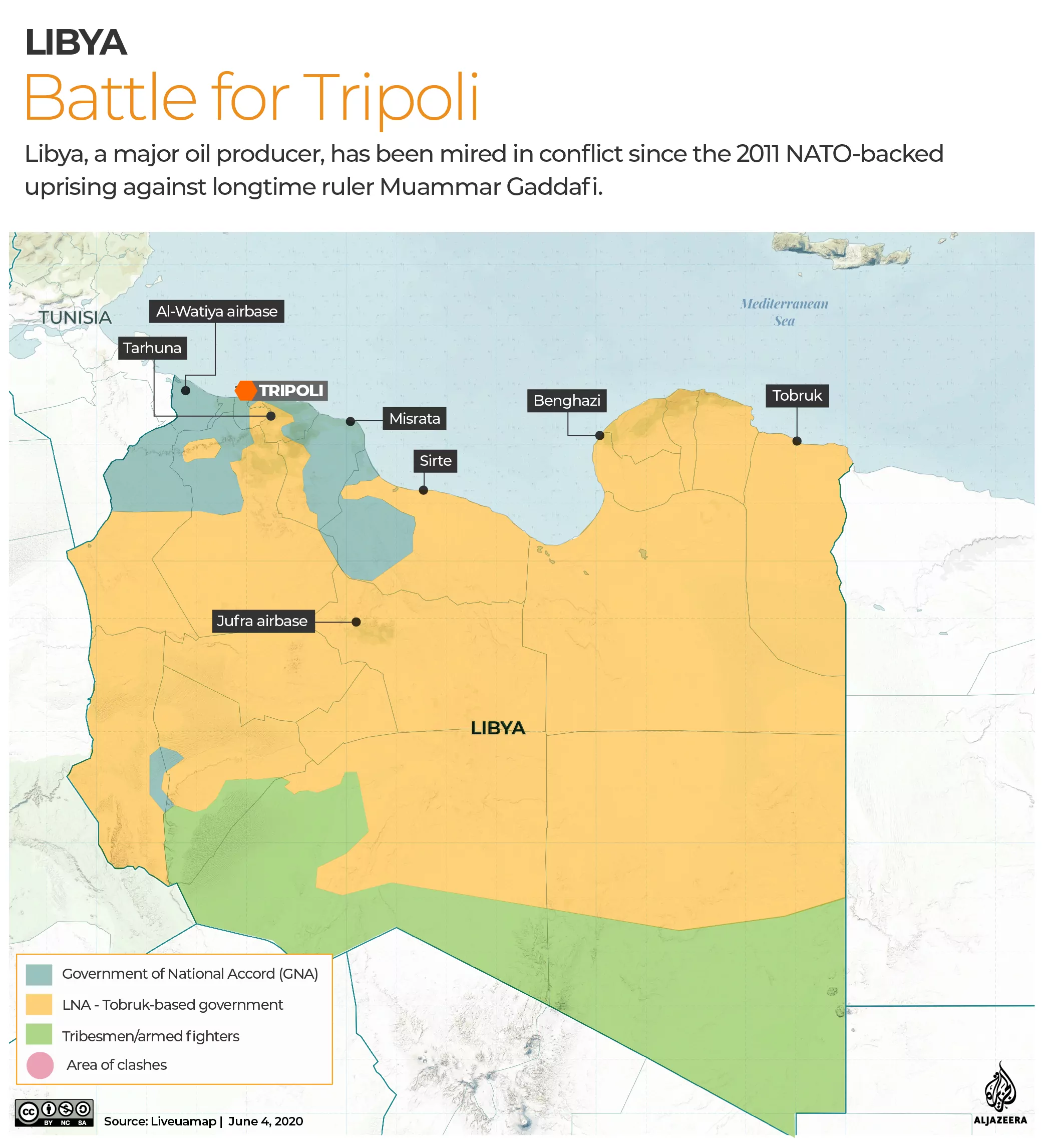
In Libyan Quagmire, Front Shifts East From Tripoli to Sirte
Publication: Eurasia Daily Monitor Volume: 17 Issue: 84
By:

The main battle line of the Libyan civil war—between the Libyan National Army (LNA), led by the self-proclaimed Field Marshal Khalifa Haftar, and forces loyal to the United Nations–recognized Government of National Accord (GNA)—has shifted east, from the outskirts of Tripoli to the Mediterranean city of Sirte. The latter coastal urban area is situated about halfway between Tripoli and Libya’s second-biggest city, Benghazi. Since April 2019, Haftar has been trying, unsuccessfully, to oust the GNA from Tripoli. Finally, in May 2020, with the help of arms, troops, specialists and contractors provided by Turkey, the LNA siege of Tripoli was broken (see EDM, June 8). Local forces and tribes in Tripolitania, which had previously pledged loyalty to Haftar, have turned coat and endorsed the GNA. A spokesperson for the LNA explained its forces’ overall retreat from Tripoli as a goodwill gesture to promote peace. But at the same time, he accused unnamed outside powers of undermining the GNA’s guarantees that its military units would not move farther than 60 kilometers from Tripoli in the wake of the LNA withdrawal. Last week (June 6), after meeting Haftar in Cairo, Egyptian President Abdel Fattah el-Sisi—one of the LNA’s main sponsors—announced a peace initiative for Libya, including a ceasefire beginning on June 8. Susi’s proposal was supported internationally; but the GNA announced it would not accept a ceasefire until after retaking Sirte and the Juffra airbase in central Libya (Newsru.com, June 8).

An initial assault on Sirte, on June 6, by GNA forces was apparently unsuccessful. Both Turkish and Chinese-made attack drones, reportedly supplied by the United Arab Emirates’ (UAE) Abu-Dhabi, were involved in the fighting. Manned aircraft were also reportedly employed in the Sirte fray. Attack drones, in particular Turkish-made and operated, sent to Libya by President Recep Tayyip Erdoğan, have been playing an increasingly prominent role in the Libyan war. The outcome of fighting in Sirte may decide the future demarcation of spheres of influence in Libya (Izvestia, June 8).
The Libya conflict has developed into a major proxy war, with Turkey, Qatar, Algeria, Tunisia and Italy backing the GNA, while Egypt, the UAE (Abu-Dhabi), Russia, Greece, Saudi Arabia and France support Haftar. The United States has been more-or-less neutral in this fray; but in May 2020, the US Africa Command (AFRICOM) tweeted imagery apparently confirming the deployment of up to 14 Russian MiG-29 fighter jets and Su-24 bombers from the Russian airbase Hmeimim in Syria to the Libyan airbase of Juffra (see EDM, May 26). AFRICOM implied Moscow is planning a major military deployment in war-torn Libya and has plans to establish permanent military bases. Moscow stringently denied any deployment of Russian Aerospace Forces (Vozdushno-Kosmicheskiye Sily—VKS) jets to Libya. The Federation Council (FC) defense and security committee chair, General (ret.) Viktor Bondaryev (former VKS commander), implied that if any MiG-29 or Su-24 jets are indeed in Libya, they are not VKS assets, but could have originated from a number of other nations, “since the MiG-29 was exported worldwide.” Under the Russian constitution, the deployment of military forces abroad must be approved by the FC. The Kremlin did not require and the FC did not vote for any resolution allowing a Libyan military deployment (Militarynews.ru, May 27).
Russia’s overall intensions in the Libyan fray and the nature of the alleged deployment of Russian jets to Juffra are opaque. Over two weeks have passed since AFRICOM’s allegations of Russian jet deployments in support of Haftar, but still nothing much has changed in the overall pattern of fighting on the ground: the LNA is falling back, and the GNA forces are advancing. When VKS platforms and supporting forces were deployed to Syria in September 2015, the outcome was quite different: the course of the Syrian civil war was reversed, and anti-government rebels were eventually decisively defeated by relentless bombing. Nothing of the sort seems to be happening in Libya at the moment. The MiG-29 is a light fighter, designed in the 1970s and mass-produced in the 1980s to counter the superior air forces of the US and its allies. This jet is not really designed for ground-attack sorties. The MiG-29 was deployed to multiple conflict zones in previous decades, including against US and allied forces in wars in Iraq and the former Yugoslavia, each time without much success. The VKS never sent MiG-29s to the Hmeimim airbase, in the Syria war. In Libya, the LNA would require attack planes and helicopters to stop the GNA offensive, not MiG-29s. During the brief August 2008 Russo-Georgian war, MiG-29s demonstrated they are not good at dealing with modern drones, which fly too slow—at speeds the MiG-29 cannot match without falling out of the sky. The MiG-29 is, therefore, not presently a popular fighter jet on the world market (Defence-ua.com, June 9). If Moscow, indeed, was planning a major Libyan incursion involving the Aerospace Forces, the MiG-29 would hardly be its first choice for a first-wave deployment.
The Russian military-industrial complex has already experienced serious humiliation in Libya. In the drone war around Tripoli, some ten (maybe more) Russia-made Pantsir-S1 (SA-22 Greyhound) missile/artillery anti-aircraft systems were disabled by Turkish attacks involving armed unmanned aerial vehicles (UAV). Moscow has been touting and marketing the Pantsir-S1 as the world’s best anti-UAV weapons system, which seems to have been an overstatement. This fiasco came on top of reports of Turkish electronic warfare (EW) systems besting Russian ones in Libya and previous reports of Pantsir-S1 systems destroyed by Turkish drones in Operation Spring Shield, in Syria’s Idlib Province, in February–March 2020. Russian experts have blamed Arab Pantsir-S1 operators from Egypt and UAE, who were trained by Russian specialists after Moscow sold them the system; apparently their training was not good enough (Moskovsky Komsomolets, June 8).
This time, instead of attempting a major direct military intervention, Moscow is apparently trying to promote a ceasefire agreement in Libya between LNA and GNA forces, possibly followed by some kind of power-sharing agreement via negotiations with Erdoğan—the GNA’s main sponsor (Militarynews.ru, June 10). Meanwhile, according to some pro-Kremlin sources, Moscow could be ready to ditch Haftar, who is 76 and evidently not well liked inside Putin’s administration (Lenta.ru, June 4). All this suggests that AFRICOM may have somewhat overstated the magnitude of Moscow’s immediate plans for Libya.



